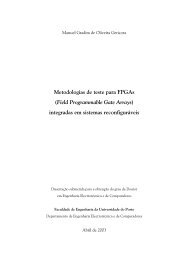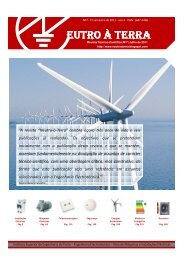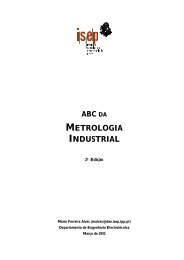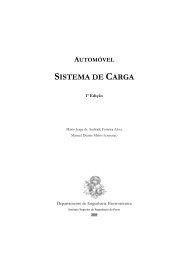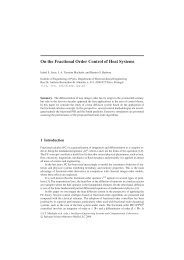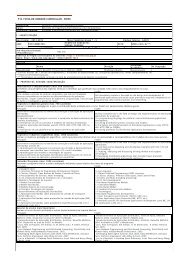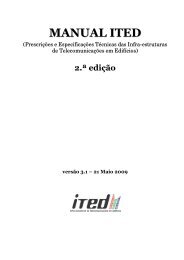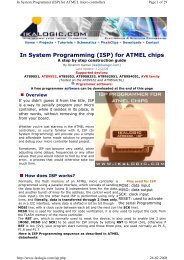describing function analysis of mechanical systems with nonlinear ...
describing function analysis of mechanical systems with nonlinear ...
describing function analysis of mechanical systems with nonlinear ...
You also want an ePaper? Increase the reach of your titles
YUMPU automatically turns print PDFs into web optimized ePapers that Google loves.
dB/dec) but differ significantly for high<br />
frequencies;<br />
• The charts <strong>of</strong> Im{−1/N} are different in all<br />
range <strong>of</strong> frequencies. Moreover, for low<br />
frequencies, the dynamic backlash has a<br />
fractional slope inferior to +80 dB/dec <strong>of</strong> the<br />
static model.<br />
Re(-1/N)<br />
10 3<br />
10 2<br />
10 1<br />
Static<br />
ε =0.7, 0.9<br />
ε =0.5<br />
ε =0.3<br />
ε =0.1<br />
3000<br />
Dynamic<br />
2500<br />
ε =0.1<br />
10 4 ω (rad/s)<br />
10 0<br />
Im (-1/N)<br />
2000<br />
1500<br />
1000<br />
ε =0.2<br />
ω=40<br />
ω=35<br />
ω=30<br />
ε =0.3<br />
ε =0.4<br />
ε =0.5<br />
ε =0.6<br />
ω=25<br />
ε =0.7<br />
500<br />
ε =0.8<br />
ω=20<br />
ε =0.9<br />
ω=15<br />
0<br />
ε→1<br />
-500 0 500 1000 1500 2000<br />
Re(-1/N)<br />
Im (-1/N)<br />
10 -1<br />
10 3<br />
10 2<br />
10 1<br />
10 0<br />
10 0 10 1 10 2<br />
Static<br />
ε =0.1<br />
ε =0.3<br />
ε =0.5<br />
ε =0.7<br />
ε =0.9<br />
Dynamic<br />
10 4 ω (rad/s)<br />
Fig. 8. Nyquist plot <strong>of</strong> −1/N(F,ω) for the dynamic<br />
backlash, F = 50 N and ε = {0.1, …, 0.9}.<br />
10 -1<br />
10 -2<br />
Im(-1/N)<br />
2500<br />
2000<br />
1500<br />
1000<br />
500<br />
F=10<br />
ε =0.2<br />
F=20<br />
F=30<br />
F=40<br />
F=50<br />
ω=25<br />
ω=40<br />
ω=20<br />
ω=15<br />
0<br />
0 200 400 600 800 1000<br />
Re(-1/N)<br />
ω=35<br />
ω=30<br />
10 -3<br />
10 0 10 1 10 2<br />
Fig. 10. Log-log plots <strong>of</strong> Re{−1/N} and Im{−1/N} vs.<br />
the exciting frequency ω, for F = 50 N and<br />
ε = {0.1, 0.3, 0.5, 0.7, 0.9}.<br />
Fig. 11 shows the time response <strong>of</strong> the output<br />
velocity x& ( ) <strong>of</strong> a system <strong>with</strong> dynamic backlash for<br />
1 t<br />
ω = {20, 40} rad/s and ε = {0.2, 0.8} revealing that<br />
we can have either chaotic or periodic responses<br />
depending on the values <strong>of</strong> ω and ε.<br />
2<br />
400<br />
1.5<br />
350<br />
ε =0.8<br />
F=50<br />
1<br />
Im(-1/N)<br />
300<br />
250<br />
200<br />
150<br />
F=20<br />
F=30<br />
F=40<br />
ω=30<br />
ω=35<br />
ω=40<br />
dx 1<br />
/dt<br />
0.5<br />
0<br />
−0.5<br />
−1<br />
100<br />
50<br />
F=10<br />
ω=20<br />
ω=25<br />
ω=15<br />
0<br />
0 200 400 600 800 1000 1200 1400 1600 1800<br />
Re(-1/N)<br />
Fig. 9. Nyquist plots <strong>of</strong> −1/N(F,ω) for a system <strong>with</strong><br />
dynamic backlash, F = {10, 20, 30, 40, 50} N and<br />
ε = {0.2, 0.8}.<br />
−1.5<br />
1.65 1.7 1.75 1.8 1.85 1.9 1.95 2 2.05 2.1<br />
time(s)<br />
Fig. 11. Time response <strong>of</strong> the output velocity x&<br />
1(<br />
t)<br />
<strong>of</strong><br />
the system <strong>with</strong> dynamic backlash, F = 50 N for<br />
ω = 20 rad/s, ε = 0.8 (solid line) and ω = 40 rad/s,<br />
ε = 0.2 (dotted line).<br />
Fig. 12 presents the Fourier transform <strong>of</strong> the output<br />
displacement <strong>of</strong> mass M 1 , F{x 1 (t)}, namely the<br />
amplitude <strong>of</strong> the harmonic content <strong>of</strong> x 1 (t) for an input<br />
force f(t) = 50 cos(ωt), ω C < ω < ω L , and ε = {0.2, 0.8}.<br />
The charts reveal that the fundamental harmonic <strong>of</strong> the



